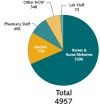Strengthening healthcare capacity through a responsive, country-specific, training standard: the KITSO AIDS training program's support of Botswana's national antiretroviral therapy rollout
- PMID: 18923699
- PMCID: PMC2556202
- DOI: 10.2174/1874613600802010010
Strengthening healthcare capacity through a responsive, country-specific, training standard: the KITSO AIDS training program's support of Botswana's national antiretroviral therapy rollout
Abstract
In parallel with the rollout of Botswana's national antiretroviral therapy (ART) program, the Botswana Ministry of Health established the KITSO AIDS Training Program by entering into long-term partnerships with the Botswana-Harvard AIDS Institute Partnership for HIV Research and Education and others to provide standardized, country-specific training in HIV/AIDS care. The KITSO training model has strengthened human capacity within Botswana's health sector and been indispensable to successful ART rollout. Through core and advanced training courses and clinical mentoring, different cadres of health care workers have been trained to provide high-quality HIV/AIDS care at all ART sites in the country. Continuous and standardized clinical education will be crucial to sustain the present level of care and successfully address future treatment challenges.
Figures





Similar articles
-
Assessing Nurses' Adherence to the See-and-Treat Guidelines of Botswana's National Cervical Cancer Prevention Programme.Cancer Prev Res (Phila). 2020 Mar;13(3):329-336. doi: 10.1158/1940-6207.CAPR-19-0348. Epub 2019 Dec 18. Cancer Prev Res (Phila). 2020. PMID: 31852663 Free PMC article.
-
The Madikwe Forum: a comprehensive partnership for supporting governance of Botswana's HIV and AIDS response.Afr J AIDS Res. 2012 Mar;11(1):27-35. doi: 10.2989/16085906.2012.671252. Afr J AIDS Res. 2012. PMID: 25870895
-
Public-private partnerships and antiretroviral drugs for HIV/AIDS: lessons from Botswana.Health Aff (Millwood). 2005 Mar-Apr;24(2):545-51. doi: 10.1377/hlthaff.24.2.545. Health Aff (Millwood). 2005. PMID: 15757942
-
Global health diplomacy: Provision of specialist medical services in the Republic of Botswana.Surgeon. 2022 Aug;20(4):258-261. doi: 10.1016/j.surge.2021.04.011. Epub 2021 Jun 13. Surgeon. 2022. PMID: 34134930 Review.
-
Caring for the caregivers: models of HIV/AIDS care and treatment provision for health care workers in Southern Africa.J Infect Dis. 2007 Dec 1;196 Suppl 3:S500-4. doi: 10.1086/521113. J Infect Dis. 2007. PMID: 18181701 Review.
Cited by
-
Patient and Provider Satisfaction With a Comprehensive Strategy to Improve Prevention of Mother-to-Child HIV Transmission Services in Rural Nigeria.J Acquir Immune Defic Syndr. 2016 Aug 1;72 Suppl 2(Suppl 2):S117-23. doi: 10.1097/QAI.0000000000001058. J Acquir Immune Defic Syndr. 2016. PMID: 27355498 Free PMC article.
-
Mentorship needs at academic institutions in resource-limited settings: a survey at Makerere University College of Health Sciences.BMC Med Educ. 2011 Jul 29;11:53. doi: 10.1186/1472-6920-11-53. BMC Med Educ. 2011. PMID: 21801406 Free PMC article.
-
Five-year outcomes of initial patients treated in Botswana's National Antiretroviral Treatment Program.AIDS. 2008 Nov 12;22(17):2303-11. doi: 10.1097/QAD.0b013e3283129db0. AIDS. 2008. PMID: 18981769 Free PMC article.
-
Optimizing PMTCT service delivery in rural North-Central Nigeria: protocol and design for a cluster randomized study.Contemp Clin Trials. 2013 Sep;36(1):187-97. doi: 10.1016/j.cct.2013.06.013. Epub 2013 Jun 29. Contemp Clin Trials. 2013. PMID: 23816493 Free PMC article. Clinical Trial.
-
Integrated clinical and quality improvement coaching in Son La Province, Vietnam: a model of building public sector capacity for sustainable HIV care delivery.BMC Health Serv Res. 2015 Jul 17;15:269. doi: 10.1186/s12913-015-0935-8. BMC Health Serv Res. 2015. PMID: 26184505 Free PMC article.
References
-
- Puvimanasinghe J, et al. MASA Report. Gaborone: Ministry of Health Botswana; 2007.
-
- Wester CW, Bussmann H, Avalos A, et al. Establishment of a public antiretroviral treatment clinic for adults in urban Botswana lessons learned. Clin Infect Dis. 2005;40:1041–1044. - PubMed
-
- Aitken J-M, Kemp J. HIV/AIDS equity and health sector personnel in Souther Africa. EQUINET Discussion Paper Regional Network for Equity in Health in Southern Africa (EQUINET) 2003 Report No. 12.
-
- Huddert J, Picazo O, Duael S. Issue paper. Washington, USA: Support for Analysis and Reseach in Africa (SARA) Academy of Educational Development; 2003. The Health Sector Human Resource Crisis: An Issues Paper.
-
- Kober K, Van Damme W. Scaling up access to antiretroviral treatment in southern Africa: who will do the job? Lancet. 2004;364:103–107. - PubMed
LinkOut - more resources
Full Text Sources
